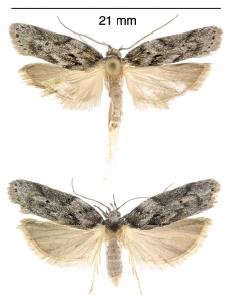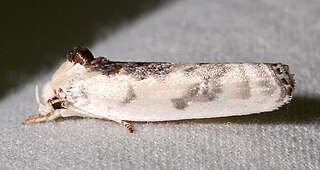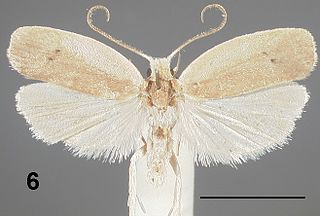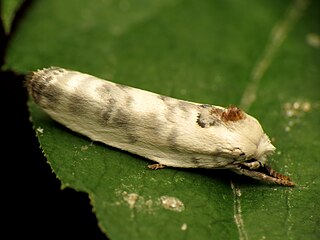
The Italian Radicals is a liberal and libertarian political party in Italy. Founded on 14 July 2001 with Daniele Capezzone as their first secretary, the party describes itself as "liberale, liberista [and] libertario", where liberale refers to political liberalism, liberista is an Italian term for economic liberalism, and libertario denotes a form of cultural liberalism concerning moral and social issues. According to its constitution, the party "as such and with its symbol does not take part in elections".

Antaeotricha arizonensis is a moth of the family Depressariidae. It is found in the United States in the mountain ranges in south-eastern Arizona and south-western New Mexico. Although Antaeotricha arizonensis are easily differentiated within their genus through the dark spots on their forewings, the distinction between sexes of A. arizonensis can be complicated. The sexes of A. arizonensis (male&female) differentiate between themselves by distinct characteristics on their antennas and anatomy of their genitalia(Ferris, 59)

Antaeotricha is a genus of moths. It is the largest genus in the subfamily Stenomatinae, numbering over 400 species in the Western Hemisphere.
Antaeotricha vacata is a moth of the family Depressariidae. It is endemic to Grenada and Trinidad in the Caribbean.

Antaeotricha osseella is a moth of the family Depressariidae. It is found in North America, where it has been recorded from New York, New Jersey, North Carolina, South Carolina, West Virginia, Maryland, District of Columbia, Massachusetts, Pennsylvania, Illinois, Arkansas, Missouri, Texas and California.

Antaeotricha floridella is a moth of the family Depressariidae. It is found in North America, where it has been recorded from peninsular Florida.
Antaeotricha horizontias is a moth of the family Depressariidae. It is found in Amazonas, Brazil.
Antaeotricha isomeris is a moth of the family Depressariidae. It is found in Brazil.
Antaeotricha carabodes is a moth of the family Depressariidae. It is found in Guyana.
Antaeotricha humerella is a moth of the family Depressariidae. It is found in Brazil (Amazonas), French Guiana, Guyana and Panama.
Antaeotricha thysanodes is a moth of the family Depressariidae. It is found in Guyana, French Guiana and Brazil.
Antaeotricha spurcatella is a moth of the family Depressariidae. It is found in Guyana and Honduras.
Antaeotricha arachnia is a moth of the family Depressariidae. It is found in Guyana.
Antaeotricha tectoria is a moth of the family Depressariidae. It is found in Guyana, French Guiana and Brazil.
Antaeotricha semisignella is a moth in the family Depressariidae. It was described by Francis Walker in 1864. It is found in Amazonas, Brazil.
Antaeotricha fascicularis is a moth in the family Depressariidae. It was described by Philipp Christoph Zeller in 1854. It is found in Guyana, French Guiana and Brazil (Amazonas).

Antaeotricha leucillana, the pale gray bird-dropping moth, is a moth in the family Depressariidae. It was described by Philipp Christoph Zeller in 1854. It is found in North America, where it has been recorded from New Hampshire, Massachusetts, New York, Pennsylvania, District of Columbia, Virginia, North Carolina, Georgia, Alabama, Arkansas, Missouri, Kansas, Illinois, Iowa, Texas, Oregon, Louisiana, Manitoba and Nova Scotia.
Antaeotricha isosticta is a moth in the family Depressariidae. It was described by Edward Meyrick in 1932. It is found in Mexico.
Antaeotricha argocorys is a moth in the family Depressariidae. It was described by Edward Meyrick in 1931. It is found in Brazil.
Antaeotricha lindseyi is a moth in the family Depressariidae. It was described by William Barnes and August Busck in 1920. It is found in North America, where it has been recorded from California, Arizona and New Mexico.




